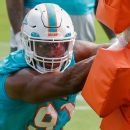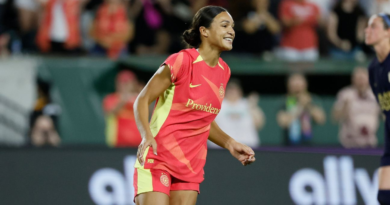Way-too-early projections for the NHL's 4 Nations Faceoff rosters
After hockey fans went many years without best-on-best international competition, the NHL’s 4 Nations Face-off will see the best players from Canada, Finland, Sweden and the United States compete in Montreal and Boston from Feb. 12-20.
Each nation has named six players to its roster, with the rest to be named closer to the tournament. All four teams have a plethora of talent, so for the first time in nearly a decade, fans will get to see the best players in the world compete against each other on the international stage.
Sidney Crosby, Nathan MacKinnon and Connor McDavid skating for Canada. Auston Matthews, Jack Eichel and the Tkachuk brothers for Team USA. The stacked blue line for Sweden, and two-way center depth for Finland.
Before the NHL season gets rolling, here is our projection of what each of the four rosters will look like:

![]()
United States
The national team development program has done a fantastic job of developing American superstars. The reigning Rocket Richard, Norris and Vezina Trophy winners and the best goaltending depth in the tournament is a good start. The Americans are well set up at every position to have success, while the other three teams have weaknesses in one position.
It really doesn’t matter which centers play the wing, but Matthews, Eichel and Dylan Larkin make the most sense to be permanent fixtures in the middle for the all-around game. The luxury of a 40-goal man (Brock Boeser) as a spare — should any of the American forwards falter — is quite something. The forwards are likely to come down to who is in the best form when it comes to decision time, as the U.S. could take any of Clayton Keller, Cole Caufield or Vincent Trocheck. The gap between those on the team and those who just missed is razor thin, and it is easy to see a scenario where any number of those players make the team due to performance or injury.
The defensemen were relatively easy to select, with the Norris Trophy winners expected to the lead the power play. Charlie McAvoy and Jaccob Slavin bring proven shutdown ability, which will be key in this tournament. Brock Faber was brilliant in his rookie season and should make the team if that performance continues into his sophomore year. Zach Werenski may or may not be healthy, potentially opening the door for Noah Hanifin or John Carlson to get in the lineup.
The toughest decision was in goal, where the Americans are loaded. To put it in perspective, one of Jake Oettinger, Thatcher Demko or Jeremy Swayman will be left off the team. Any one of those goaltenders would be better than any current Canadian option — the depth is tremendous. Demko is there now, but mystery surrounding his injury may see him lose his spot to Oettinger or Swayman if he doesn’t get healthy and perform well. Regardless of which three the Americans choose, all three are capable of stealing games, including reigning Vezina winner Connor Hellebuyck.
![]()
Canada
Canada is loaded up front with the three generational players in Crosby, McDavid and Connor Bedard. Bedard is not a lock in the eyes of Hockey Canada, but he should be on the team if he gets off to a strong start.
The toughest choice up front was Nick Suzuki over Mark Stone, with Steven Stamkos as the extra. Stone’s injuries are a factor, and he will get significant consideration if healthy. Suzuki brings a valuable two-way game, can play multiple roles and should fit nicely in Canada’s bottom six. Stamkos is the spare, but no one should be surprised if he takes a spot in the bottom six to boost the power play. Other players who likely will be considered up front are Travis Konecny and Wyatt Johnston.
Things get complicated on the blue line, with Canada having quite a few elite defensemen on the right side. Cale Makar and Devon Toews make sense as a natural top pairing. Noah Dobson had a fantastic 2023-24 season, is better defensively and has flown under the radar. Shea Theodore and Josh Morrissey make sense on the left side, with Owen Power and Morgan Rielly likely to get consideration.
Evan Bouchard is the most interesting debate, given his ascension to stardom last season. Having four members of the electric Oilers power play must be enticing, but Makar is likely to run the top unit. If Canada doesn’t see Bouchard running a power play, they may look to the likes of Alex Pietrangelo or Aaron Ekblad for their defensive game, with Bouchard as the spare. Shaping the defense will certainly be the toughest for Canada’s brain trust, given the plethora of talent available.
The goaltending is … not great. While Canada has an overabundance of talent in the skater category, they lack in goaltending. Jordan Binnington, Stuart Skinner and Adin Hill have demonstrated they are capable of winning high-pressure games. However, all three have had moments or long stretches of games where they cannot be trusted. Canada can ill afford to choose pedigree over which goaltender is playing the best given who they will face in this event. If Tristan Jarry and Joel Hofer play well to start the season, Canada will have no choice but to consider them here, as having a goalie in form is vital.
![]()
Sweden
Sweden has some interesting decisions to make all over their lineup. Elias Pettersson, Joel Eriksson Ek and Mikael Backlund represent strong two-way play with scoring prowess. If Gabriel Landeskog returns without setback, it is easy to see how Sweden would consider bringing him to the tournament. Rickard Rakell will get consideration if he plays well to start the season, and could take a spot from Gustav Nyquist, Lucas Raymond or Leo Carlsson.
Sweden has the option to go young or give veterans one last kick at international competition; a mix of both is likely the best route.
About that blue line: Victor Hedman, Gustav Forsling, Erik Karlsson and Rasmus Dahlin is some kind of top four. The Swedish defensemen are a who’s who of Norris Trophy conversations over the past decade. Behind that group, Mattias Ekholm has been consistently steady, and Hampus Lindholm plays a key shutdown role on a great team. Their inclusion frees up Karlsson and Dahlin from penalty killing, and should allow them to thrive offensively. Jonas Brodin will be in the mix too, with Rasmus Andersson and Adam Larsson likely to get consideration for bottom-pair roles. Sweden’s depth on the blue line will be a major strength.
If Jacob Markstrom plays the way he’s capable of in New Jersey, he is likely to back up Linus Ullmark. Both goalies have been in the Vezina conversation in recent seasons, with Ullmark playing more consistently over the past few seasons. Jesper Wallstedt goes in favor of Samuel Ersson, given that Sweden views him as a key piece of their international landscape in the future. If Ersson vastly outplays Wallstedt in the early season, he may get the nod, but it is unlikely either sees action in the tournament if Ullmark and Markstrom are healthy.
![]()
Finland
Finland’s strength is up front, where its center depth includes Aleksander Barkov, Sebastian Aho, Roope Hintz and Anton Lundell. Other nations have more scoring depth, but Finland has three centers who are elite two-way players, while Lundell is developing into a two-way stud.
Outside of Mikko Rantanen, Finland lacks elite scoring talent on the wings. If Patrik Laine can find his form in Montreal, he’s likely to play higher in the lineup and score. Eeli Tolvanen and Joel Armia are on the bubble up front, if players like Laine or Mattias Maccelli don’t have good starts to the season. Expect Finland to play a tight checking game and rely on their elite two-way players to win low-scoring games. This is a country that has had significant success in recent international tournaments, so they shouldn’t be overlooked despite that relative lack of pop.
On the blue line, Finland is led by Miro Heiskanen — the only true star on the back end. He will log major minutes, play in all situations and quarterback the power play. Olli Maatta and Juuso Valimaki could trade places depending on their performance. Expect Esa Lindell, Rasmus Ristolainen and Niko Mikkola to be key penalty killers and bring a physical element to the defensive zone.
Juuse Saros will be a huge part of Finland’s ability to contend in this tournament, and is a shoo-in to be the starter. Saros will likely be backed up by Ukko-Pekka Luukkonen or Kaapo Kahkonen, but is likely to remain Finland’s starter for the entire tournament.



